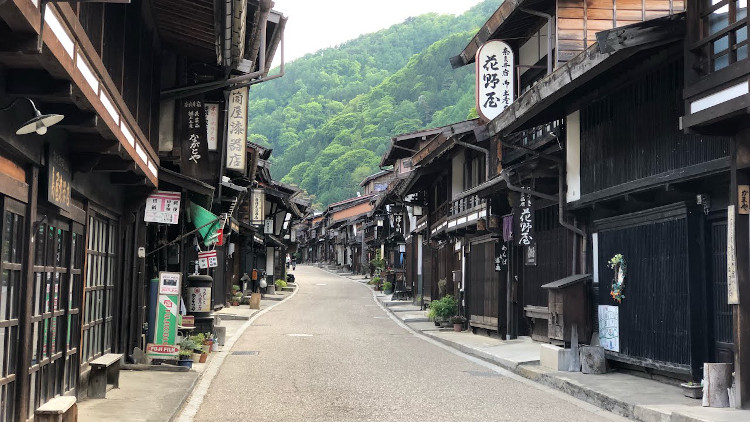
Many of us have a yearning for old-style village life: a community of people just getting on with living and working together; appreciating each other’s strengths and accepting each other’s foibles. Aikido Village is a quest for just such an experience in an aikido context.
The founder’s art has become increasingly fractured. Aikido Village aims to celebrate diversity and cultivate joy through the sharing and practice of this wonderful art.
Through a collaborative approach we seek to reconnect with the heart of aikido; appreciate the insights from different styles and teachers; and seek to use all of the tools of the West to help us understand and invigorate this fabulous art from the East.
Aikido Village provides no syllabus or promotions, we focus solely on offering opportunities for people to explore aikido further. Bow in, we’d love to hear from you…
Sunday 19th February at 3pm (AEDT) with guest presenters
Lissette Delgado-Fitzgerald and Dan James
You can use the following Zoom link to join us:
https://us02web.zoom.us/j/83037264801?pwd=dU5mNEJDeGJ3VEJuVVlJKzFBVHUrUT09
Meeting ID: 830 3726 4801
Passcode: 928122
Assunta Morrone: Gender Equality in Aikido
Assunta talked about the dojo as a microcosm of society, both of which predominantly organised
through patriarchal power structures. This shows for instance in the over-representation of men in
technical committees as well as senior teaching roles, and women in senior roles often finding
themselves in admin or organisational supporting functions to the patriarch of the dojo. This can be
seen in Australia as well as overseas, as a look at the gender distribution in the US Aikido
Federation’s Technical Committee demonstrated, and at the struggle needed to bring about any
female representation, which led to the creation of the Independent Coalition of USAF Women.
This was followed by a look at the causes for women not participating, in particular investigating
gender-based violence, which often goes under-reported. The movement #MeTooAikido was
brought to attention, which was started by Neilu Naini, who was raped by her sensei as a young
student. Assunta also shared some of her own experiences, for example of women aikidoka being
ignored as uke for demonstrations by a senior Japanese instructor at a seminar; the sensei, when
challenged about this, deflected the blame back on the women saying they were not giving any
indication of wanting to be called up. The next day of the seminar, about 15 women deliberately sat
in the front row so he had to call them up.
Assunta concluded that sometimes lack of gender equality is not necessarily intentional, but what
happens when the privileged are not aware of their privilege. And that irrespective of merit, doors
are open for men, where women have to push them open. Also, that most men (apart from gay or
trans men) rarely need to think about personal safety, whereas women constantly assess their safety
in every environment.
The question of female only training environments was briefly touched on, and the conscious choice
of who to train with. Assunta concluded her presentation with a Janice Taitel quote on the cost of not speaking up.
Clare Engel: Challenges to Retention of Women in Training
Clare started by sharing the results of a small gender related survey she conducted among senior
male sensei of her school, which was that to them gender identity was not the defining factor when
dealing with students, but the individual and their needs.
She then elaborated on the challenges women face in a male dominated dojo environment
especially when first starting out. This ranged from white pants not being very period friendly, to
women feeling unsafe entering a male dominated sphere, to the observation that many women’s
path to seniority is delayed by taking long breaks in their training for having children. These and
further challenges result in low rates of women joining dojos as well as to a high attrition rate for
women.
Clare continued by looking at what can be practically done to provide women with a supportive
environment that allows them to feel safe and welcome. This led into a discussion of measures to
encourage inclusivity, for example through the Welcome Here Project and Safe Space (see resources
below). Clare outlined different measures that had been trialled, for example running intro classes
for women, media campaigns, and measures to invite women into leadership roles, and highlighted
the importance of developing an individual plan of training with the student.
She concluded with a call for reassessing the relevance of how things should work.
Joanne Martin: How Aikido Can Help Us Evolve by Balancing the Masculine and Feminine Energies
Joanne drew the focus from the political and pragmatic towards the energetic, by looking at the
interplay of masculine and feminine energies in the context of aikido and its expression by
practitioners of either gender.
She pointed out that aikido was in its very nature an example of balanced masculine and feminine
energy, for instance as expressed in the two roles of uke and nage. She then focused on what the
balanced versus distorted masculine and feminine each looked like, and that by training in aikido,
men and women got to work on both aspects of themselves, thus creating more balanced
individuals. For example, women can find it challenging or even confronting to learn to give a good
attack as uke, whereas male aikidoka may find it challenging to receive with gratitude. By
consciously understanding the qualities of both sides, the aikidoka was able to consciously work on
their growth and evolution.
The same held true for the energy of a dojo, where the presence of women could help to bring
balance, from which both sexes benefitted.
In the context of personal growth, Jo encouraged everyone to bring awareness to who we were
drawn to train with on the mat, and who we avoided, and that growth often happens when we
challenge our habitual comfort zone.
Recommended Resources and Reading:
Regarding gender equality:
#MeTooAikido: https://www.metooaikido.com/forum
Independent Coalition of USAF Women, a group of senior women in the United States Aikido
Federation appealing to the USAF to examine and improve gender equity in the organisation:
https://www.facebook.com/ThoseStupidGirls/
Interview with Janice Taitel Sensei https://www.youtube.com/watch?v=fM-MyTAC9Bs
Regarding inclusivity:
The Welcome Here Project, which supports businesses and services throughout Australia to
create and promote environments that are visibly welcoming and inclusive of lesbian, gay,
bisexual, transgender, intersex and queer (LGBTIQ) communities:
https://www.welcomehere.org.au/
Equivalent in the US: http://www.safespaceamerica.org/
Academic paper on aikido in the lives of women aikidoka:
Noad, K. (1996). Samurai of Gentle Power : An Exploration of Aikido in the Lives of Women
Aikidoka. Free to download at https://ro.ecu.edu.au/theses_hons/707/
Blog posts and articles:
https://guillaumeerard.com/aikido/articles-aikido/the-female-practitioner-s-guide-to-
hombu-dojo/
https://grabmywrist.com/2016/04/x-chromosomes-being-a-woman-in-aikido/
https://aikidojournal.com/2018/09/25/why-aikido-is-great-for-women/
On Takako Kunigoshi https://simonechierchini.com/2020/08/23/takako-kunigoshi-
kobukan-dojo-artist-and-budoka/
Further reading on women in martial arts:
Hoppe, Stephanie.T. (1998). Sharp Spear Crystal Mirror. Martial Arts in Women’s Lives.
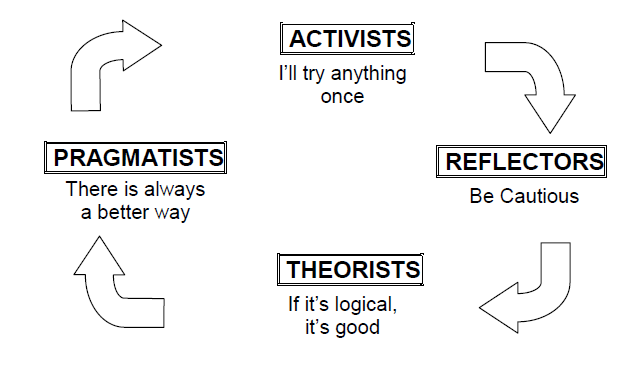
Jim Nichols – Honey and Mumford learning cycle
Jim talked about moving on from the VAK (Visual Auditory Kinesthetic) method of teaching towards the learning styles highlighted by Honey and Mumford. The four different ways in which people prefer to learn that they identified, relate to a different stage in the learning cycle. These are Activist, Reflector, Theorist and Pragmatist.
In this model the learning styles are described as a continuum that one moves through over time. However, over time, people usually come to prefer and rely on one, or more, style(s) above the others. Research has shown that there is no evidence that one preference is better than another – indeed the diversity of our learning styles adds value to team work and organisational functioning.
Activists – involve themselves fully and without bias in new experiences. They enjoy the here and now and are happy to be dominated by immediate experiences.
Reflectors – like to stand back to ponder experiences and observe them from many different perspectives. They collect data, both first-hand and from others, and prefer to analyse them thoroughly and think about them from every possible angle before coming to any definite conclusions.
Theorists – like to analyse and synthesise. They assimilate and convert disparate facts and observations into coherent, logical theories. Their philosophy prizes rationality and logic above all.
Pragmatists – are keen on trying out ideas, theories and techniques to see if they work in practice. They search out new ideas and take the first opportunity to experiment with applications.
John Ward – What is learning and what is the process of learning?
The habituated mind implies the absence of thought. Experience is our greatest teacher
5 stages of learning:
Learning is initiated when some dilemma or tension appears regarding a problem or surprising experience
Learning derives from experience and, in particular, from experiences in which mistakes were made
Learning almost always involves change which begins by acknowledging the dilemma or tension and the doubt regarding the efficacy of proposed action that intimates learning behaviour
Learning involves reframing
Reframing is the process of reinterpreting the world in light of alternative perspectives and values; reframing involves seeing problems in a different way and reconfiguring knowledge.
The habituated mind (of settled beliefs) is exposed to surprise or doubt which unsettles our beliefs which leads to enquiry, training and practice – within Aikido we have to trust and accept the martial system as a framework for our enquiry. From here we can fix our beliefs which leads to revised settled beliefs…and so it goes.
In martial arts we go from the Child mind (open and curious) to the Beginner’s mind (willingness to trust and practice) to the Learner’s mind (going through the iterative process above) to the Sceptical mind (Sandan crisis) to No mind.
Mike Vanderdonk – Process, Learning, Practice and Skill
Once you have a well-defined process, being able to apply the process to differing content becomes easy.
Learning is ‘getting’ the process – this can involve experimentation
Practice is then applying that process again and again with different content in different environments.. and as you progress in your expertise you can do this with different destabilisations – start adding more interesting things to the mix, to make it more challenging (making the process or practice harder and harder)
Training is teaching that process then stabilising the environment for the learner.
Skill is applying the correct process to the presented content.
Aikido Village honours Michael Williams Sensei
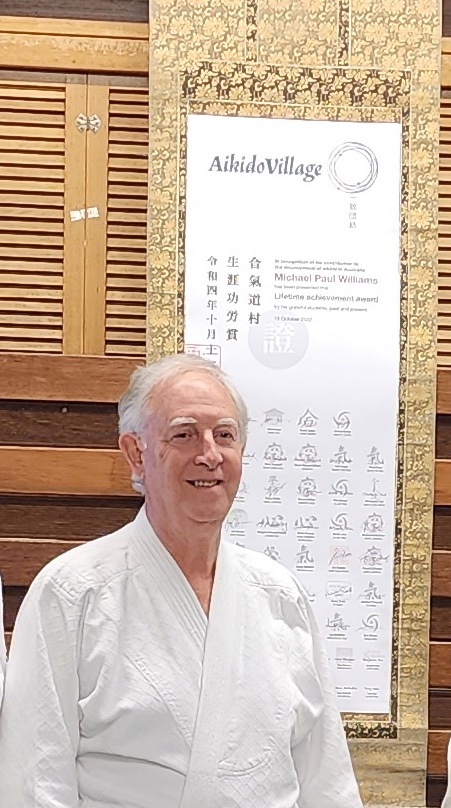
Aikido Village was pleased to present Michael Williams Sensei a lifetime achievement award on Saturday 15 October 2022 for his distinguished service to aikido in Australia.
Michael introduced ki-aikido to Australia when he started classes at Griffith University in 1981. He relocated to Byron Bay in 1987 and built Goshinkan dojo, the headquarters for ki-aikido in Australia from 1991 to 2006. Michael was the head of the Ki Society in Australia from 1985 to 2001 before embarking on the global expansion of Aikido Yuishinkai in 2002 as International Chief Instructor. Michael founded his own school of aikido, Goshinkai, in 2014. Through his efforts hundreds of dojos have been established worldwide and many dojos in Australia owe their existence to his efforts. he has touched the lives of thousands of people through his Aikido and continues to pursue his personal study of Aikido and to share it with others.


Aikido Village is an international meeting place that transcends schools, styles and hierarchies. Through a collaborative approach we seek to reconnect with the heart of aikido; appreciate the insights from different styles and teachers; and seek to use all of the tools of the West to help us understand and invigorate this fabulous art from the East. Aikido Village provides no syllabus or promotions, we focus solely on offering opportunities for people to explore aikido further.
While villagers engage mostly regularly online due to the challenge of geography, a friendship seminar is planned for March 2023 in South Tweed.
The award was presented by Andrew Sunter, Daniel James, Mark Evans and Mark Albrecht who are co-creators of Aikido Village and between them represent over a century of dedicated training in aikido.
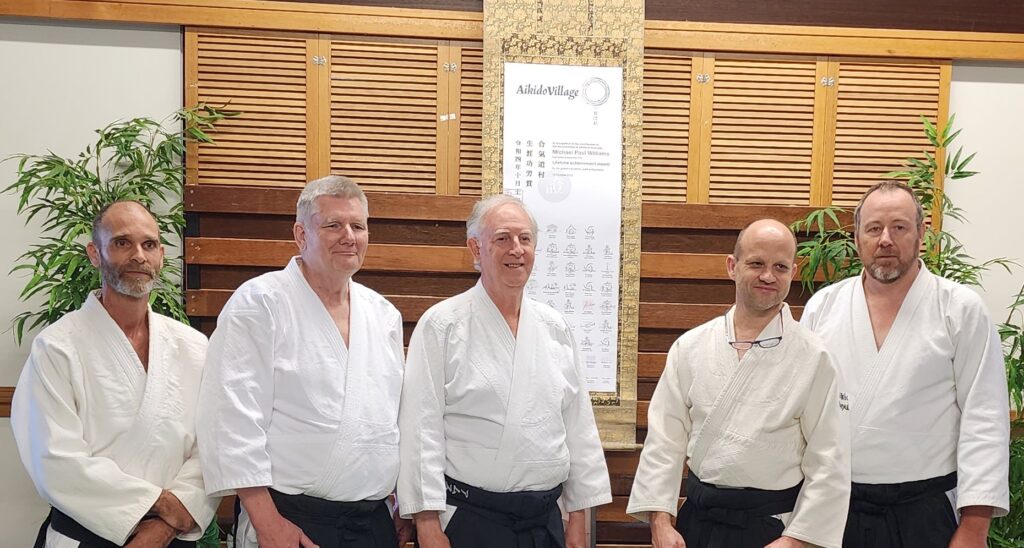
The award was signed by 53 of Michael’s current and former students who have all gone on to run aikido dojos of their own around Australia as well as in New Zealand, Singapore, Laos and the UK.

Standing: John Ward, Steve Phillips, Gess Vella, Andrew Long, Mark Evans, Andrew Sunter, John Gam, Michael Williams, Daniel James, Mark Albrecht, Rod Nixon-Smith, Sharma Wrightson, Benjamin Tan, Elisabeth Andel, Dave Matthews, Steve Dows, John Dell
Seated: Mark Campbell, Shane Griffiths, Joe Hansen, Joanne Martin, Michael Karkkainen, Lawrence Ellyard.
Signatories not in photo:
Rudran Brannock, Stuart Clifford, Cate Coupe, Tracey Griffin, Kate Gunton, Chris Hall, Barry Hamilton, Margaret (Hassett) Harley, Galina Ivanova, Martin John, James McGlone, Jim Nicholls, Russell O’Connor, Simon Russell, Daniel Rylatt, Catherine Schnell, Jimmy Smith, Jonathan Temporal, Michael Vanderdonk, Mac White, Lou Whittaker, Bob Withers
Peter Costin-Neilsen, Alison Lane, Anthony Rasmussen, Clem Sturgess, Thom Hansen, Sid Monthulé, Aran Bright, Beau McGuffie, Tony Neal
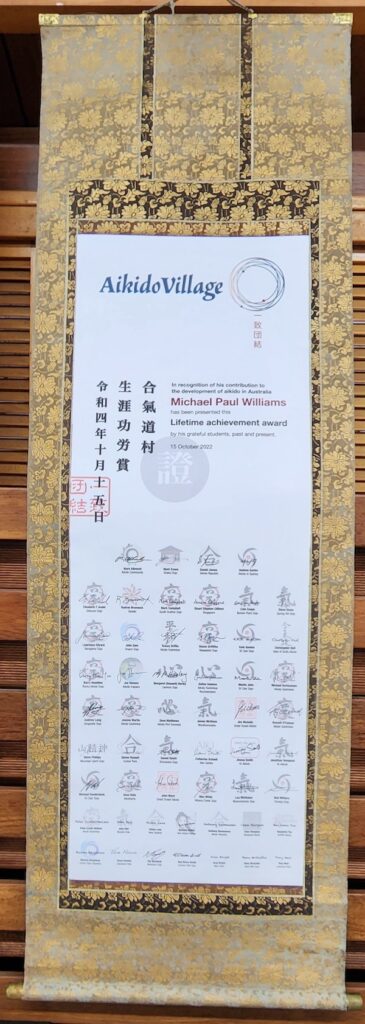

The contention was that the basic idea of Ukemi being the ‘art of defensive falling’ can be expanded to be ‘anything required of uke in the paired practice of Aikido’.
Some of Uke’s roles:
• Following on from the idea in the Internal Power discussion that the ‘core is the main transmitter of power’ – Uke needs to be moving from their centre.
• Having and keeping good structure – kinetic chain.
• From IP discussion ‘relative power in posture’ – knowing when you’re off balance.
• ‘Relax completely’ – in order to be responsive.
• Looking for tsuki (leading to Kaeshi-waza) – If Uke is always aware of the gaps that Nage creates (without exploiting them) then when it comes to learning reversals they are well placed to do so
• Stability not balance – trying to maintain/regain stability throughout the technique.
• Connecting to your partner and maintaining that connection – the best way to feel what someone, who is moving from their centre, is doing is to connect to that centre.
• Not resisting, not being a rag doll – “don’t fight use ki, don’t resist take ukemi” – Maruyama Sensei.
Training the same principles whether uke or nage means that you are training 100% of the time – not taking ukemi while ‘waiting to do your aikido’ (technique).
Ki testing is a useful tool to help Uke move correctly. When Ki testing is applied and the force becomes overwhelming then Nage moves as a unified whole rather than off-balancing. The same principle can be applied to Uke so that they move in a coordinated way.
Dan James – Skill acquisition and the Uke / Nage interaction (See Dan’s notes – learning a skill)
Dan talked about ‘Error free learning’ and how correction and feedback can impair the learning path as well as negative feedback having a stronger neural pathway than positive feedback. He also talked about Blocked vs. Random learning and how there is a place for both. As well as Implicit vs Explicit learning and how training to exhaustion means the conscious mind shuts down.
His conclusions:
• Uke is the teacher
• Rote learning is powerful in early stages
• Learning is a multimodal activity
• Aikido traditional paradigm has many learning modalities
• Guiding learning is a complex skill
• Feedback by Uke can drastically change learning process
• Random and implicit modalities are needed to unlock higher levels of learning
• Uke needs to provide “goldilocks” feedback, that is unique and appropriate to Nage’s learning needs.
• Limpfish, dominance behaviour, blocking-of-movement correction, multiple explicit minute verbal correction are all sub optimal behaviors.
Andrew Sunter – The interplay between Uke and Nage in Atemi-jutsu
Andrew drew from his experience with Atemi-jutsu to talk about the respective roles of the active partner (Nage) and the reaction partner (Uke) with a view to providing analogues to the Uke / Nage interaction in Aikido. The reaction partner’s role is to support the learning of the active partner and provide the best, most honest, feedback possible. They need to provide an appropriate level of challenge; not move faster or slower than the active partner; respond appropriately (which requires an understanding of anatomy and the spinal reactions that occur when injury is created); and not to talk at all during the interaction. At more advanced stages the reactive partner increases the challenge by adding in strikes or counters and eventually tries to turn the tables on the active partner and ‘steal their turn’ – effectively practising Kaeshi-waza.
The following is a submission from Dave Matthews who couldn’t make the discussion:
“The complex role of Uke in Aikido? I think it depends on how you define Aikido. For me I see it as the method to harmonise the flow of energies. As a result, I think there is no such thing as static aikido. Uke’s role is to provide a constant flow of energy towards nage. Nage’s job is to smoothly join with this flow and lead uke to a point of instability . Static techniques are just a way to teach beginners the alphabet of aikido. Actual Aikido begins after this. The contact point is where the uke’s flow and nage’s meet. Ideally nage should smoothly join with this flow of energy but this is difficult for beginners to do for the entire technique. This is true for both uke and nage.. As a result I often start techniques statically at the contact point as if it has been paused there. Uke then continues to provide a flow of energy towards nage as if the play button was once again pressed.”
Coincidentally, this popped up in my Fb feed today, a post from Quentin Cooke (7th dan) in the UK :
“When we practise aikido we take one of two roles, uke or nage. it is not unusual to have the majority of the class focus on teaching the ‘nage’ role, but all too often little attention is spent on teaching the role of uke. A pity, as if anything this is where you can learn the most. They are essentially two sides of the same coin and when aikido is done well, it looks seamless and as if both parties are working as one, which in fact they are.”
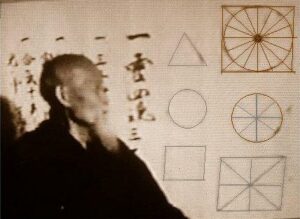 Internal strength/power is something that appears cyclically in martial arts from time to time. It’s sometimes rooted in esoteric practices and postural work and can potentially inform our practice of Aiki. In this session through several seniors with expertise in other arts and professional disciplines of therapy and biomechanics we explore internal strength from many viewpoints.
Internal strength/power is something that appears cyclically in martial arts from time to time. It’s sometimes rooted in esoteric practices and postural work and can potentially inform our practice of Aiki. In this session through several seniors with expertise in other arts and professional disciplines of therapy and biomechanics we explore internal strength from many viewpoints.
Slides from the session: click here
Chinese martial Arts – Simon Russell (long time practitioner of Chinese MA and Aikido)
- Listen to the audio that Simon recorded for the session
Japanese martial arts – Andrew Sunter (Aikido instructor with a history of cross training across styles / arts)
- Because there is no real mention of internal power in japanese martial arts, but there is mention of Aiki, the contention was that Internal Power (IP) is Aiki. Even then Aiki is not really well defined and there seem to be a lot of different definitions, from the physical to the esoteric. However it plays a Key part of many sword schools, Jujitsu schools, Judo and Daito Ryu. Practicing Aiki leads to Aiki body.
- One of the early references to aiki (1899) – “The most profound and mysterious art in the world is the art of Aiki. This is the secret principle of all the martial arts in Japan. One who masters it can be an unparalleled martial genius.”
Pedagogical challenges – Dan James (biomechanist and skill acquisition researcher)
- There is pedagogical challenge if want to bring IP into the Aikido dojo since traditional aikido training is paired partner practice but what we see from Chinese and older Japanese arts is that internal power needs largely a solo practice in order to cultivate it. So how can be bring solo practice to the dojo and our own practice at home?
- People can get distracted and focused on the word ‘strength’ and it becomes more about fighting which isn’t really Aiki. Danny’s contention was that IP informs Aiki but is different.
A biomechanics perspective – Dan
- In Aikido, power is relative because you are working with another physical body. If you work on your own power you can improve relative to your partner but if you can take the power / Ki out of your partner then your relative power increases significantly.
- Some of the ways to do that: Use ground power; Kinetic chain; Balance.
- Solo training needs to be tested with paired practice – we need to have both training paradigms
Aiki Body – ‘an integrated approach’ – Andrew Sunter
- At the centre of building Aiki body is building the core/hara but it’s not really explicitly taught in martial arts.
- We need to focus on engaging the core because it’s the main transmitter of power and we need to transfer power from the ground via the core to the hands with as little leakage of power as possible
-
- Engage the core
-
- Then…
-
-
- Relax – swap using phasic muscles for tonic muscles
- Extend the structure – in 6 directions
- Align the spine
- Stabilise shoulders and arms
- Switch on glute medius
- Extend up and down
-
-
-
- We can use the Rites of spring from Daito Ryu to help as it contains spiralling, winding, aiki age, aiki sage and balance
-
- Use testing to determine what is working – calibrate 0-100% of force and ensure the same tests at the same levels are consistently applied. Try different things and see how it affects the results. However, it’s not enough to do this static we need to maintain our structure under movement.With paired practice we can test this but we need to have an uke committed to giving us consistent feedback.
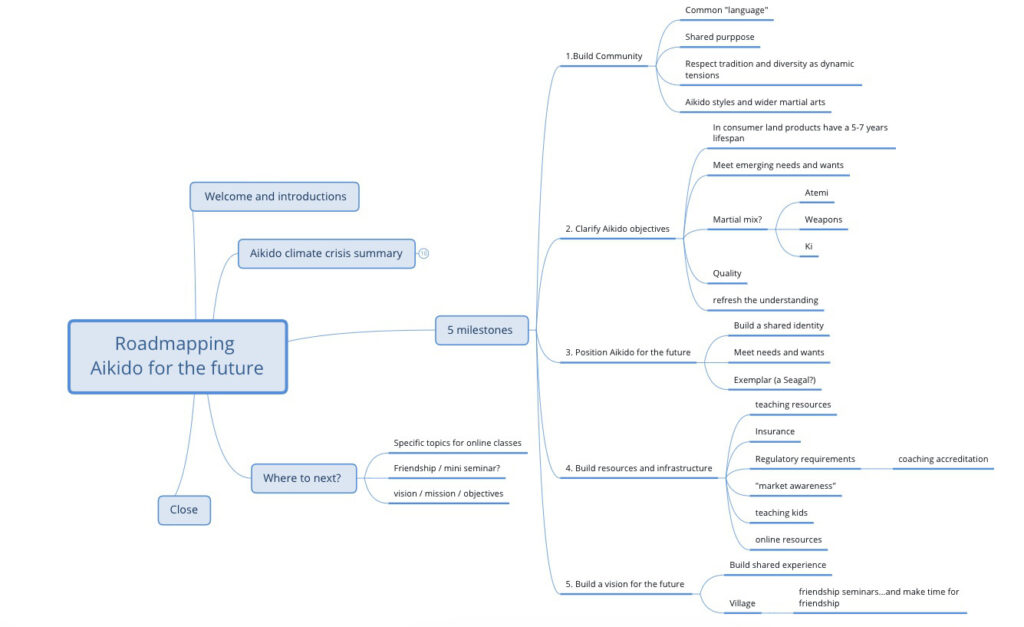
Communities of Aikido are important, in imagining what aikido looks like in the future respecting the traditions of the various styles that come together, celebrating the similarities and being open to exploring the differences is pivitable. rediscovering our shared purpose – that of mutual respect and willingness to share and learn from each other and also a vocabulary that can be used to express what is happening that is understandable to all.
There was a lively discussion of the role of atemi and weapons and how relevant they are in the post-war version of Aikido that most of us are learning. And why often Aikido is not seen as martially effective and whether we want to change that perception or continue with the ‘branding’ of the Art of Peace. The general consensus was that as a martial art there needs to be an understanding of the martial roots and how to ensure that the techniques can be viable ‘on the street’ but that a lot of people are practicing for other reasons (including social, health, mental health and conflict resolution).
As communities grow, the resources they have at their disposal also grow and the concept of ‘not re-inventing the wheel’ was seen as highly desirable. There is a wealth of experience (sometimes hard won) in our respective circles and a willingness to freely share these resources was seen as a community building activity helping to ensure a core of information that can help any club become established and grow into the future.
We touched on the subject of Internal Power and the different takes and understandings and this has become the topic of the next event on the 31st of July. There was also a general consensus that holding a friendship seminar would be desirous and something that all the attendees would like to see.